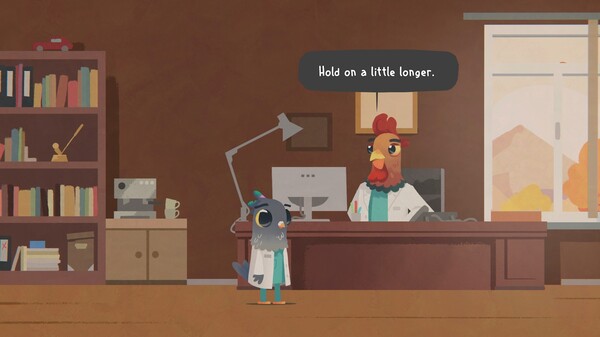
A cross between Grey’s Anatomy and Night in the Woods may seem like a strange premise for a video game, but Fall of Porcupine is just that, and it’s part of a growing market for narrative games that have something useful to say about the world.
Created by former film-makers, the game is set in a cozy small-town hospital run by cute animals. Starring a doctor called Finley, beset by the problems facing healthcare providers the world over, it’s a game that tells the stories of medical staff and the people they treat, as well as the administrative problems they face through under-funding and the drive to profitability.
The game’s developer is German independent Critical Rabbit, made up of creatives who migrated from the world of film. Lead game designer Sebastian Heße tells GameDaily that he “felt more comfortable telling stories through video games,” than through film. “It’s more exciting because games are still such a new thing that we’re still working out how to tell stories with it. It’s really fun to figure out the best way to do that.”
Idealistic approach
Finley is an idealistic young doctor who takes a position in a small town hospital. According to Heße, the doctor “has to face the reality of the system he’s in, and the troubles and issues associated with hospitals. He has to learn that a hospital is also a company that is interested in making money. Sometimes you need to find a good way to make money but not to damage your patients.”
Through mini-games and dialog trees, Finley learns the stories of his patients. Heße says: “We all have personal experience of hospitals and some of the frustrations of going to them. But most of us know someone who works in a hospital and who is dealing with those systems every day. We wanted to make a game that respects the people who are actually working in healthcare”
The characters in the game are animals, but they are dealing with real world issues. “We tried to make it as realistic as possible,” says Heße. “You can be in a cartoony, quirky animal hospital. But the facts have to be correct.”
During the game’s development, the team interviewed hospital workers, amassing around 50 hours of transcripts that are “full of interesting stories”. Although the game cannot incorporate all those stories, it focuses on the relationships between medical staff and patients, which is often compromised by overwork and under-staffing.
Narrative clarity
The art-style and narrative clarity of smash indie hit Night in the Woods is clear in the game’s story-telling approach. “Night in the Woods created a completely new way of telling real stories in games, and I agree that it’s been an inspiration for us,” says Heße. “But we are also inspired by games like Life is Strange and Oxenfree that tell stories that are intensely personal.”
That said, TV hospital dramas are a relatively unusual inspiration in games. “I’m a big fan of shows like Scrubs and Grey’s Anatomy,” says Heße. “This is the kind of setting that has a lot of potential to tell stories. You have a single location, and a core team, but also, you have patients who come and go and who have a variety of personalities and stories.”
The game has enjoyed a positive reception on Steam and from reviewers. Kotaku said it’s “cozy, but there’s plenty of depth” while GameStar’s reviewer called it their “story game of the year”.
Heße says the game is not based on any particular country’s system of healthcare. Germany has a socialized medical system, but also insurance for those who want better treatment and coverage. “Every country has healthcare issues,” he said, referring mainly to resources and costs. “There’s no place in the world that has figured out the perfect way to treat their citizens.”
Games set in hospitals are nothing new. But in general, they tend towards the mechanical and humorous, like Two Point Hospital, in which players have to build medical facilities, or Surgeon Simulator, which has fun with surgery techniques.
Unlike TV hospital shows Fall of Porcupine is not big on medical jargon. “When characters on TV talk about medical stuff, you don’t have to interact with it,” says Heße. “But in a game, you can’t expect players to be able to process this kind of technical information, so we keep things on that side more simple.”
As a small team, Critical Rabbit is currently focused on patching the recently released game, and translating it for more international audiences. Then they’ll move their focus onto a new game. Heße says a sequel is a possibility. “The community around the game is so enthusiastic and friendly, but we’ll have to wait and see how the game sells before we make a decision.”
You can find out more about Fall of Porcupine here.
Colin Campbell has been reporting on the gaming industry for more than three decades, including for Polygon, IGN, The Guardian, Next Generation, and The Economist.
 GameDaily.biz © 2025 | All Rights Reserved.
GameDaily.biz © 2025 | All Rights Reserved.